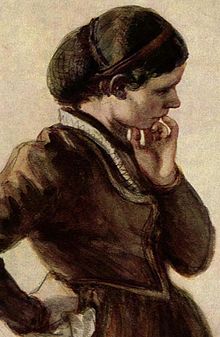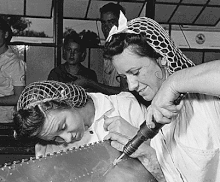Snood (headgear)


A snood (/snuːd/) is a type of traditionally female headgear, with two types known. The long-gone Scottish snood was a circlet made of ribbon worn by Scottish young women as a symbol of chastity. In the 1590s, snoods were made using Florentine silk ribbon for the gentlewomen at the court of Anne of Denmark by Elizabeth Gibb.[1]
The other type was intended to hold the hair in a cloth or net-like hat.[2][3] In the most common form, the headgear resembles a close-fitting hood worn over the back of the head. It is similar to a hairnet,[3] but snoods typically have a looser fit.[4]
Decorative hairnets, popular among women in the Victorian era, were referred to as snoods. This term was then applied to any netlike hat, and, in the 1930s, to a net bag headgear. This latter meaning became popular during the Second World war when women joined the workforce en masse and were required to wear the headgear to avoid their hair getting caught by the moving parts of the factory machinery.[2]
For a short time during WWII, the snoods were at the height of fashion (a hit of Paris collections in 1939).[5]
Beard snood
[edit]Another similar garment which is also referred to as a snood is used to cover facial hair such as beards and moustaches when working in environments such as food production.[6] Although it appears that "hairnet" has replaced "snood" as the common term for hair containment on the head, the term "beard snood" (essentially a "ringed scarf") is still familiar in many food production facilities.[citation needed]
Religious use
[edit]Women's snoods are often worn by married Orthodox Jewish women,[7] according to the religious requirement of hair covering (see Tzniut). Since these snoods are designed to cover the hair more than hold it,[8] they are often lined to prevent them from being see-through. Contemporary hair snoods for Jewish women come in a wide range of colors and designs.[9]
In the 21st century, the women use snoods primarily for religious reasons.[10]
References
[edit]- ^ Jemma Field, "Dressing a Queen: The Wardrobe of Anna of Denmark at the Scottish Court of King James VI, 1590–1603", The Court Historian, 24:2 (2019), pp. 158–159. doi:10.1080/14629712.2019.1626120
- ^ a b snood at the Encyclopædia Britannica
- ^ a b "History of Hair Covering Part #1: Snoods". Archived from the original on 21 August 2019. Retrieved 5 January 2020.
- ^ Karen Roemuss; Martin Green; Leo Palladino (2018). Professional Hairdressing: Australian and New Zealand Edition (2nd ed.). ISBN 978-0170415927.
Snoods ... They're like a hair net but have a looser fit and much coarser mesh ...
- ^ Blum 1993, p. 28.
- ^ "SmartGuard Beard Snood | | Food Industry Workwear | Disposable Workwear | Protective Workwear | Personal Protective PPE". Protec Direct. Archived from the original on 2012-03-21. Retrieved 2011-09-23.
- ^ "Rabbis' Rules and Indian Wigs Stir Crisis in Orthodox Brooklyn". The New York Times. May 14, 2004.
- ^ Silver, Rivki (5 February 2012). "Me and My Covered Hair, Part Two: Tichels, Hats and More". Retrieved 5 January 2020.
- ^ "Snoods VS. Sheitels". Retrieved 5 January 2020.
- ^ Lynch et al. 2014, p. 276.
Sources
[edit]- Blum, Dilys E. (1993). "Ahead of Fashion: Hats of the 20th Century". Philadelphia Museum of Art Bulletin. 89 (377/378). Philadelphia Museum of Art: 1–48. ISSN 0031-7314. JSTOR 3795480. Retrieved 2024-11-15.
- Lynch, A.; Strauss, M.D.; Eicher, J.B.; Bradley, L.A.; Braithwaite, N.; Buckridge, S.O.; Camerlengo, L.L.; Colburn, C.A.; Collins, V.; Craik, J. (2014). "Snood". Ethnic Dress in the United States: A Cultural Encyclopedia. Rowman & Littlefield Publishers. pp. 276–277. ISBN 978-0-7591-2150-8. Retrieved 2024-11-12.

